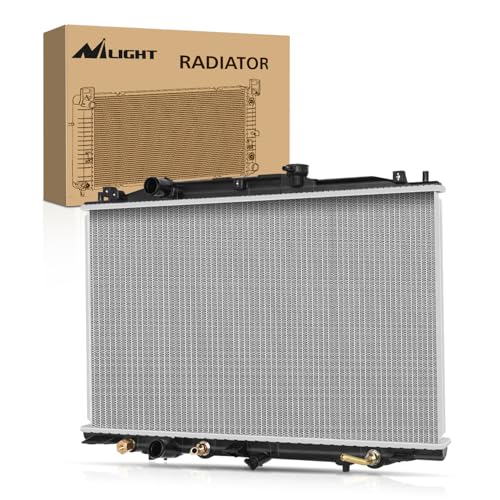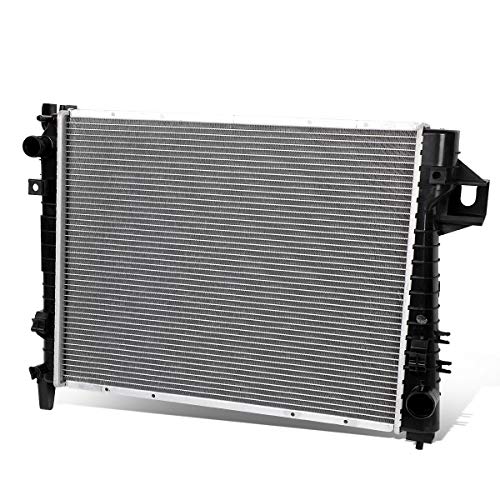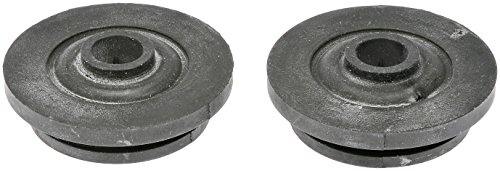There’s a unique bond you form with a car like the 7th generation Honda Accord. It’s more than just a vehicle; it’s a reliable partner that’s seen you through years of commutes, road trips, and daily errands. I remember the day my own trusty Accord started acting up. The temperature gauge, normally rock-solid in the middle, began creeping towards the red zone during stop-and-go traffic. A quick pop of the hood revealed the dreaded sweet smell of coolant and the tell-tale green residue crusting the top of the original radiator. The plastic end tank had finally surrendered after nearly two decades of faithful service. Ignoring this is a recipe for disaster—a blown head gasket or a seized engine can turn an affordable repair into a decision to scrap the car entirely. The search for a replacement began immediately, leading me to a popular and budget-friendly option: the Nilight Radiator for Honda Accord 2003-2007.
- 【Vehicle Fitment】 - Radiator for Honda Accord 2003 2004 2005 2006 2007 2.4L FWD. Core Thickness: 5/8;Core Width:28-1/4;Core Height: 15-5/8;Inlet Diameter:1-1/4;Outlet Diameter:1-1/4....
- 【Reference Number】CU2797, 2797, 2599, 3185, 19010RAAA11, 19010RAAA72, 19010RJEA01, 19010RAAA81, 19010RAAA71, 19010RAAA12, 19010RAAA11, 19010RAAA72, 19010RJEA01, 19010RAAA81, 19010RAAA71,...
- 【Performance】Our radiators are 100% leak tested to prevent coolant loss and keep the engine running efficiently. Increases the boiling point of the engine coolant to maintain efficiency. Maintains...
What to Consider Before Buying a Replacement Radiator
A radiator is more than just an item; it’s the heart of your vehicle’s cooling system. It’s a key solution for dissipating the immense heat generated by an internal combustion engine, ensuring it operates within its optimal temperature range. A high-quality radiator prevents overheating, protects critical engine components from damage, and ultimately ensures the longevity and reliability of your vehicle. The main benefits are simple but profound: engine protection, improved performance, and peace of mind on the road. Without a properly functioning radiator, you’re not just risking a breakdown; you’re risking the life of your engine.
The ideal customer for an aftermarket radiator like this is typically the hands-on owner of an older, high-mileage vehicle. You’re someone facing a component failure who wants to get your car back on the road without spending a fortune on OEM parts from a dealership. You likely have some mechanical aptitude and are looking for a cost-effective solution. However, this type of product might not be suitable for those who prioritize absolute, worry-free reliability above all else, or for owners of newer, high-value vehicles where an OEM part is a more prudent investment. If you’re not comfortable with the potential for minor fitment adjustments or quality control variances, you might consider OEM or premium aftermarket brands, though they come at a significantly higher price point.
Before investing, consider these crucial points in detail:
- Dimensions & Fitment: This is non-negotiable. An aftermarket radiator must be a “direct-fit” replacement. Check that the core dimensions (height, width, thickness), inlet/outlet diameters, and mounting tab locations precisely match the original unit. Any deviation can turn a simple swap into a nightmare of custom fabrication and potential leaks.
- Cooling Performance: The radiator’s primary job is to cool. Look at the core design. A higher fin density and well-designed tubes (like the louvered aluminum fins on the Nilight model) provide a larger surface area for heat exchange, leading to more efficient cooling. The goal is performance that is equal to or better than the stock unit it replaces.
- Materials & Durability: Most modern radiators use a combination of an aluminum core for excellent heat transfer and plastic (or ABS) end tanks to reduce weight and cost. While this construction is standard, the quality of the plastic and the method used to crimp it to the aluminum core are critical for long-term durability. A full aluminum radiator offers superior strength but is often more expensive and heavier.
- Ease of Use & Maintenance: A good replacement should be a simple “plug-and-play” installation. This includes having correctly placed ports for all hoses, transmission cooler lines, and fan shroud mounts. Long-term care is minimal, but ensuring the radiator cap neck is well-machined and provides a perfect seal is paramount for maintaining system pressure and preventing coolant loss.
While the Nilight Radiator for Honda Accord 2003-2007 is an excellent choice for many, it’s always wise to see how it stacks up against the competition. For a broader look at all the top models, we highly recommend checking out our complete, in-depth guide:
- OEM FITMENT - 34 Inch Core Radiator Compatible with Chevy Silverado Suburban Tahoe Cadillac Avalanche Escalade GMC Yukon Sierra Hummer H2 4.3L 4.8L 5.3L 6.0L 6.2L
- POWERFUL & ADJUSTABLE HEATING: Offers an adjustable thermostat and three heat settings - High (1500W), Medium (900W), and Low (600W) - allowing you to customize the warmth to your comfort level.
- DIRECT OEM FIT - 34 Inch Core Radiator Compatible with Chevy Silverado Suburban Chevrolet Avalanche GMC Yukon Sierra Tahoe Escalade Hummer H2 4.3l 4.8l 5.3l 6.0l 6.2l v8.
First Impressions: Unboxing the Nilight Radiator
The Nilight Radiator for Honda Accord 2003-2007 arrived in a large, but surprisingly lightweight, cardboard box. Pulling it out, the first thing we noticed was its low weight of just over 8 pounds, a direct result of its aluminum and ABS construction. This makes handling during installation significantly easier than with older, heavier brass/copper units. The aluminum core had a clean, polished finish, and the plastic end tanks looked sturdy enough at first glance. However, upon closer inspection, we immediately spotted an issue that many other users have reported: several sections of the delicate cooling fins were bent. While this is often cosmetic and can be carefully straightened with a fin comb, it speaks to potential packaging or handling issues and is a disappointing first impression. Despite this, all the connection points—the main inlet/outlet ports and the smaller transmission cooler line fittings—appeared to be in the correct locations for a seamless installation.
What We Like
- Excellent price point offers significant savings over OEM parts.
- Direct-fit design matches factory mounting points and hose locations perfectly.
- Lightweight construction makes installation easier to manage.
- Aluminum core is designed for efficient heat dissipation.
What We Didn’t Like
- Prone to arriving with bent or damaged cooling fins.
- Major concerns with radiator cap fitment, posing a serious risk of leaks.
- Quality control on the plastic components, like the overflow tube, can be inconsistent.
A Deep Dive into the Nilight Radiator’s Real-World Performance
A radiator’s worth isn’t determined on the workbench, but under the hood, enduring heat cycles and pressure in real-world driving conditions. We put the Nilight Radiator for Honda Accord 2003-2007 through its paces, from the initial installation to stress-testing its cooling capabilities, to uncover whether its attractive price is a bargain or a liability.
Installation and Fitment: A Near-Perfect OEM Match
This is where the Nilight radiator truly shines. For a budget-friendly aftermarket part, the precision of its form factor was impressive. The entire installation process was remarkably straightforward. After draining the old coolant and removing the fans, hoses, and the two top mounting brackets, the old, cracked radiator lifted right out. Sliding the new Nilight unit into place felt just like installing an OEM part. The mounting posts on the bottom seated perfectly into the factory rubber grommets, and the top brackets aligned without any need for persuasion or modification. This is a huge plus for any DIY mechanic, as fighting with misaligned parts can add hours of frustration to a job.
The upper and lower radiator hose necks were correctly sized and angled, allowing the original hoses to slide on and clamp down securely. Furthermore, the threaded fittings for the automatic transmission cooling lines screwed in smoothly and tightened without any issue, creating a leak-free connection. The fan shroud’s mounting points also lined up exactly as they should. This level of dimensional accuracy is commendable and confirms the experiences of many users who praised its “perfect fit.” The lightweight nature of the radiator was a welcome bonus, reducing the strain of maneuvering it into the tight confines of the engine bay. From a purely mechanical fitment perspective, the Nilight Radiator for Honda Accord 2003-2007 delivered on its promise of being a direct-fit replacement.
Cooling Performance: The Aluminum Core Advantage
Once installed and filled with fresh coolant, we bled the system and took the Accord for a series of test drives to evaluate the radiator’s core function: heat dissipation. The design, which utilizes premium-grade aluminum tubes and precision-folded louvered fins, is engineered to maximize the surface area exposed to airflow. In practice, this translated to solid performance under normal operating conditions. During steady highway cruising and typical city driving, the engine’s temperature needle remained stable and well within the normal range, mirroring the performance of the original factory radiator in its prime.
We then subjected it to a more demanding test: prolonged idling on a warm day followed by aggressive stop-and-go traffic, conditions that put maximum thermal load on the cooling system. Here too, the Nilight radiator held its own. The cooling fans cycled on and off as expected, and the radiator effectively shed the excess heat, preventing the temperature from creeping upwards. The manufacturer’s claim that it’s designed to increase the boiling point of the coolant (by maintaining pressure) is key to this efficiency. In these initial tests, the core itself performed admirably, proving that the fundamental design for heat exchange is sound. For those looking for an affordable part that can handle daily driving demands, its cooling capability seems more than adequate.
The Achilles’ Heel: Cap Fitment and Material Concerns
Unfortunately, the flawless installation and solid initial performance were completely overshadowed by a critical, potentially catastrophic flaw: the radiator cap neck. As we went to install the original Honda radiator cap, we immediately noticed it didn’t feel right. It twisted on but failed to lock into place with the satisfying, firm click you’d expect. It felt loose, and we could easily wiggle it. This is an enormous red flag. A radiator cap isn’t just a lid; it’s a pressure-regulating valve. A poor seal means the system cannot hold its specified pressure (typically 13-16 psi). When the system can’t pressurize, the boiling point of the coolant drops dramatically, making the engine far more susceptible to overheating, even if the radiator itself is functioning perfectly.
This finding directly confirms one of the most serious user complaints we found, where one owner stated, “the original cap does not fit very well on this radiator.” They went on to describe how this leaky cap led to an overheated car and left them stranded 70 miles from home. Upon closer inspection of the Nilight’s filler neck, we noted the sealing surface felt rougher and less precisely machined than the OEM unit. This isn’t just an annoyance; it’s a fundamental failure in quality control. Another user mentioned the overflow tube developed a hole in the “THIN plastic,” pointing to potential inconsistencies in the quality of the ABS components. While our test unit didn’t fail catastrophically, the risk posed by the poor cap seal is so significant that it undermines confidence in the product’s long-term reliability. A new radiator that can’t even hold a cap properly is a major design and manufacturing oversight. It forces the buyer into a gamble, hoping their cap seals or forcing them to buy a new one that might.
What Other Users Are Saying
Diving into feedback from other owners provides a broader picture that aligns closely with our own findings, revealing a consistent pattern of praise and problems. On the positive side, many users, like one who installed it on their 2007 Honda Accord EX, confirm it is a “perfect fit” and praise the “easy install.” This sentiment is echoed by others who found it to be a well-designed, dimensionally accurate replacement that simplifies the repair process. The lightweight nature and overall material quality are also frequently mentioned as positives, especially given the very competitive price point.
However, the negative feedback highlights two recurring and significant issues. The first is shipping damage, with multiple reviewers stating their unit arrived with “damage” in the form of “indents on the fins.” While this is often cosmetic, it’s a persistent annoyance. The second, more critical issue is the one we experienced directly. One user’s story is particularly cautionary: “the cap leaked and the overflow tube developed a hole… Got stranded with an overheated car.” This experience of being left stranded due to a component failure directly linked to poor quality control on the filler neck and plastic fittings is the biggest risk associated with this product. It paints a picture of a radiator that is a lottery: you might get a perfectly functional unit, or you might get one with flaws that could lead to engine-damaging consequences.
How Does the Nilight Radiator Compare to the Competition?
While we focused on the Nilight Radiator for Honda Accord 2003-2007, it’s helpful to understand the broader market. The alternatives listed are for different vehicles, but they illustrate the variety of options available to consumers, from full radiator replacements to individual components.
1. Auto Dynasty Radiator, 2002-2004 Dodge Ram 1500 2500 3500, 1-Row Aluminum Core
- Vehicle Compatibility - This radiator is compatible with Dodge Ram 1500 3.7L 4.7L 5.7L 2002-2004, Dodge Ram 2500 4.7 5.7 2002-2003, Dodge Ram 3500 5.7L 2003, fits models without radiator neck and...
- Brilliant Performance - Come with [1] high performance lightweight design cooler radiator, can make the replacement and improve engine cooling efficiency, making stronger and higher capacity for...
- Solid Construction Design - Radiator made of high-quality ABS Plastic & T-6061 Aluminum ensuring optimum heat transfer and long service life.
The Auto Dynasty radiator for Dodge Ram trucks serves the same market segment as the Nilight: owners of older, workhorse vehicles in need of a cost-effective OEM-style replacement. Like the Nilight, it features an aluminum core for efficient cooling and is designed for direct, bolt-in installation. This product is for a truck owner who values a straightforward, affordable fix to keep their high-mileage vehicle on the road. The choice between this and the Nilight would come down entirely to vehicle application, but the purchasing motive is identical—restoring factory cooling performance without the high cost of dealership parts.
2. Dorman 926-274 Radiator Mount Bushing 2 Pack
- Direct replacement - this radiator mount bushing matches the fit and function of the factory part on specified years, makes and models
- Ideal solution - this bushing is a reliable replacement for an original part that has failed due to fatigue
- Durable construction - this part is made from quality materials to ensure reliable performance and long service life
This Dorman product highlights a crucial aspect of cooling system repair: proper diagnosis. It isn’t a radiator at all, but a set of mounting bushings. An owner might choose this if their radiator is still functional but is rattling or vibrating due to worn-out original mounts. This can prevent stress fractures and prolong the life of the existing radiator. This product is for the meticulous DIYer who has identified a specific point of failure rather than needing to replace the entire unit. It serves as a reminder that sometimes the solution is a targeted, inexpensive part rather than a complete component swap.
3. DNA MOTORING Full Aluminum Radiator for Liberty 3.7L
- Construction - Made of High Quality Full T-6061 Aluminum Construction Core; Light-weight, and High-heat Transferring Aluminum Features A Tube and Fin Design
- High Performance - Improves Cooling Efficiency, Make Heat Dissipation More Efficient to Prevent Premature Engine Failure
- Core Dimensions - 20" W X 20" H X 1" D; Inlet/Outlet Diameter - 1-1/2" , 1-13/16"
The DNA Motoring radiator for the Jeep Liberty represents a step up in durability for some applications. As a “Full Aluminum Core” unit, it suggests a more robust construction than the standard aluminum/plastic design of the Nilight. This type of radiator would be preferred by a vehicle owner who does more demanding tasks like towing or off-roading, where the extra durability of all-aluminum construction can provide greater peace of mind against leaks and failures. While still an aftermarket replacement, it’s geared towards a user who is willing to potentially spend a bit more for enhanced toughness compared to a base-level replacement.
Final Verdict: A Calculated Risk for the Savvy DIYer
So, should you buy the Nilight Radiator for Honda Accord 2003-2007? The answer is a qualified “maybe.” On one hand, its direct-fit dimensions, easy installation, and initial cooling performance are impressive for its budget-friendly price. For a DIY mechanic looking to save a significant amount of money on an older vehicle, it presents a very tempting value proposition. It bolts in perfectly and, at its core, does the job of cooling the engine effectively under normal conditions.
However, the significant and well-documented issue with the radiator cap fitment is a deal-breaker for us to give it a wholehearted recommendation. A radiator that cannot guarantee a proper seal is a liability, period. The risk of losing pressure, boiling over, and being left stranded with an overheated engine is too great to ignore. We would only recommend this radiator to an experienced individual who is willing to thoroughly inspect the unit upon arrival, immediately test the cap fit, and is prepared to purchase a separate, high-quality radiator cap to ensure a proper seal. If you’re willing to take that extra step and accept the gamble on quality control, you can save a lot of money. For anyone else seeking a fit-and-forget solution, we advise spending more on a brand with a more consistent reputation for reliability. For those willing to take the chance, you can check the latest price and see if recent batches have improved.
Last update on 2025-11-05 / Affiliate links / Images from Amazon Product Advertising API







